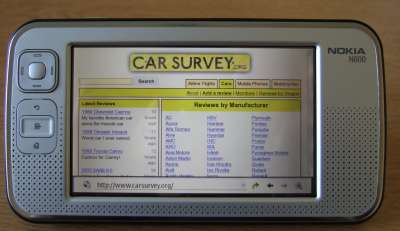On Friday night I had the chance to play with a Nokia 6120 classic for 10 minutes or so, and here are my quick impressions.
The 6120 classic is a very small HSDPA Series 60 phone. Basically a very stripped down N95, which is no bad thing. Because of this, I’m going to compare the 6120 classic to my experience of owning an N95.
N95 features missing from the 6120 classic:
- GPS – GPS is getting better on the N95 with the new Assisted GPS feature. However, it’s still more of a nice to have than an essential feature in my view
- WiFi – This is a significant loss, but is mitigated by the presence of HSDPA
- Infra-red port – Not a big issue in 2007
- TV Output – How many people actually use this in the real world?
Micro SDHC card support – 2Gb plain MicroSD in the 6120 classic vs 4Gb SDHC (and maybe higher) in the N95– See the comments
Important features shared by both phones:
- HSDPA – Super fast data. You’ll never want to use GPRS ever again. Note that you’re going to need an “unlimited” data package to make proper use of this feature
- Series 60 3rd Edition Feature Pack 1 – lovely mobile optimised WebKit browser
- Bluetooth 2.0 – Fast data transfers, and A2DP for audio
- Audible hiss on the headphone socket – I’ve heard this on all four N95s I’ve played with, and the 6120 classic was no different. Not a phone for audiophiles
- A navigation pad – A tiny joystick, as used by many phones, is a deal breaker for me
Other differences
- Physical size – The 6120 classic is a super small phone. Photos don’t do it justice. It’s very very thin for a candy bar phone. The N95 is like a brick compared to the 6120 classic
- Button size – The numeric keypad and the nav pad on the 6120 classic are good, but the buttons surrounding the nav pad are a little too small for comfort
- Build quality – The 6120 classic is very solid, and feels much better made than the N95. Annoying, given the N95 is a lot more expensive. I worry about my N95 being damaged by keys in my pocket, whereas the 6120 classic felt like it would have no such problems
- Screen size – The 2.0 inch screen on the 6120 classic is noticeably smaller than the N95’s 2.6 inch screen. The small font size in the N95 web browser (which I use) is about the same size as the normal font size on a 6120 classic
- Camera – The 6120 classic is passable with a 2 megapixel fixed focus camera, and 320×240 video at 15fps. Not a patch on the quality of the N95 though. I took the same photo with both cameras, and the N95 shot was clearly much better
- Speakers – Both the N95 and 6120 classic have very loud speakers. The only difference is that the N95 is stereo, and the 6120 classic is mono. Given how close the N95 speakers are, this is a very minor point
- Stealth – No one would ever guess the 6120 classic is a powerful smartphone; it looks just like a standard Series 40 Nokia phone
- Price – My friend who owns the 6120 classic got it for £29.99 on a £15 a month Three contract (18 months). By way of comparison, an N95 on a £20 T-Mobile contract is £249. That fits with Nokia’s suggested sim free price for a 6120 classic of 260 Euros (£176). I’m not sure if that includes tax, but as a comparison, the N95 sim free is still going for around £450. That’s a huge difference
In summary, the 6120 classic is a seriously impressive phone. I’m not going to swap my N95 for one, but if I was looking to buy an N95 now, I’d struggle to justify it over the 6120 classic. WiFi, GPS, the bigger screen, and the better camera are definitely worth having, but I’m not sure they’re worth £250 extra.
See the All About Symbian 6120 classic Review if you want more detail and photos of the 6120 classic.
